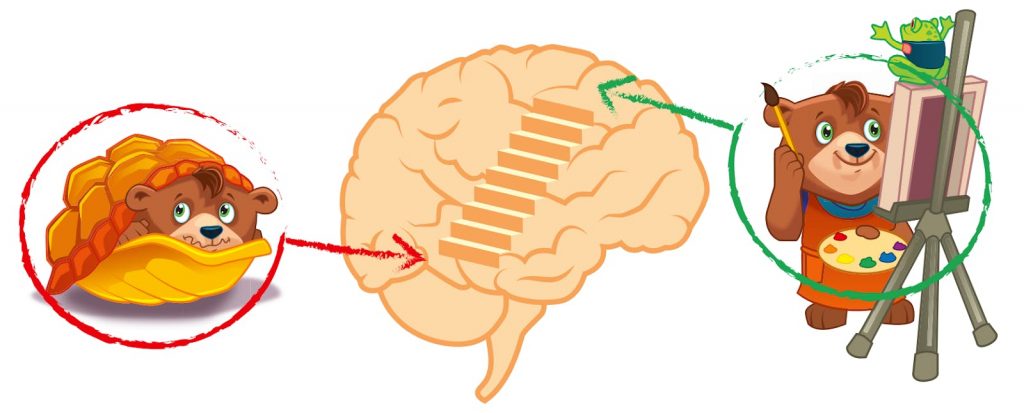Article written by Jessica Sinarski, LPCMH, author of Riley the Brave – The Little Cub with Big Feelings!
Find yourself wondering why kids can’t use their words sometimes? This is true of all of us, but especially true for brains that have been impacted by trauma. Here’s an excerpt from the “afterword for grown-ups” of Riley the Brave to help make sense of this complicated topic…
—–
Upstairs/Downstairs Brain
(see The Whole-Brain Child by Daniel J. Siegel and Tina Payne Bryson)
The brain has two main operating systems, social-approach/engagement mode (“the upstairs brain”) and defense mode (“the downstairs brain”). At birth, the downstairs brain is the operating system at work. This system is home to primal feelings like terror and rage. The infant cries out (because even gas bubbles feel life-threatening to a newborn), and the loving parent rocks and soothes and tries to meet the child’s need. It takes thousands of repetitions of this call and response to start building neural highways to the more advanced operating system—the upstairs brain.

Even with great care and connection, we humans all have “porcupine” and “turtle” moments.
Unfortunately, when an infant or young child experiences trauma, especially the loss of a biological parent, he adapts to his dangerous life by strengthening, and primarily using, his downstairs brain. But in the downstairs operating system, he can’t find connection, trust, or safety. The downstairs brain doesn’t even house language— except the kind of language you don’t want to hear!
In order to engage in relationships and experience calm, every cub needs a safe “big critter” to help find the trail back to that upstairs brain. The tricky part is that when kids lose the connection between their upstairs and downstairs brains, it is only natural for parents to do the same. Your child’s “tiger moment” might trigger a “turtle moment” in you, keeping you both trapped in a cycle of defense and mistrust.

So how do you break the cycle?
Increasing playfulness and utilizing non-verbal cues like a warm gaze and a gentle approach gives everyone a chance to get back in upstairs brain mode. While Riley the Brave deals with a very difficult topic, this book is playful and accessible, hopefully helping those reading it to strengthen their upstairs brain. It provides a boost for both caregiver and child. Instead of continuing the cycle of defence and mistrust, you both get to enjoy a moment of connection—a shared moment in your upstairs brains. And let’s be honest, that’s where we all want to spend our time—engaged and learning, feeling happy and safe.

Jessica Sinarski, LPCMH equips parents and professionals to be healers for hurting children. Weaving user-friendly brain science into everything she does, Jessica ignites both passion and know-how in audiences. Extensive post-graduate training and 15+ years as a clinician, consultant, and parent educator led her to create BraveBrains, a resource and training platform for home, school, and community. She is also the author of the Riley the Brave picture books.